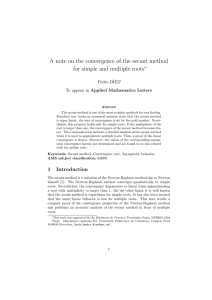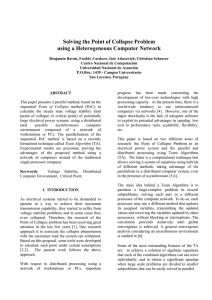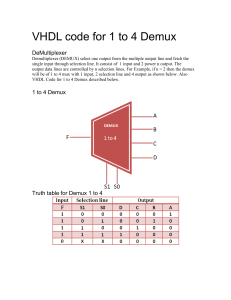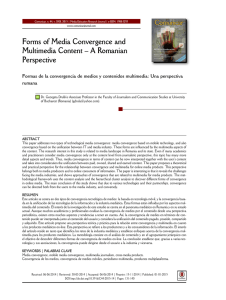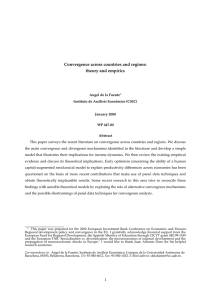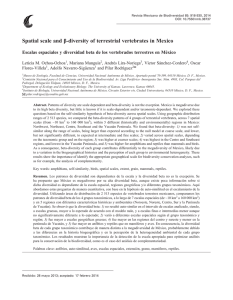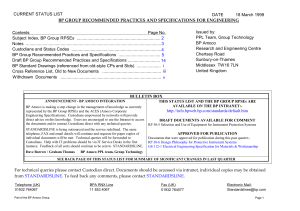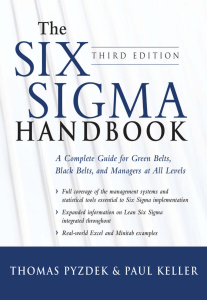Opportunity cost of CO2 emission reductions - E
Anuncio
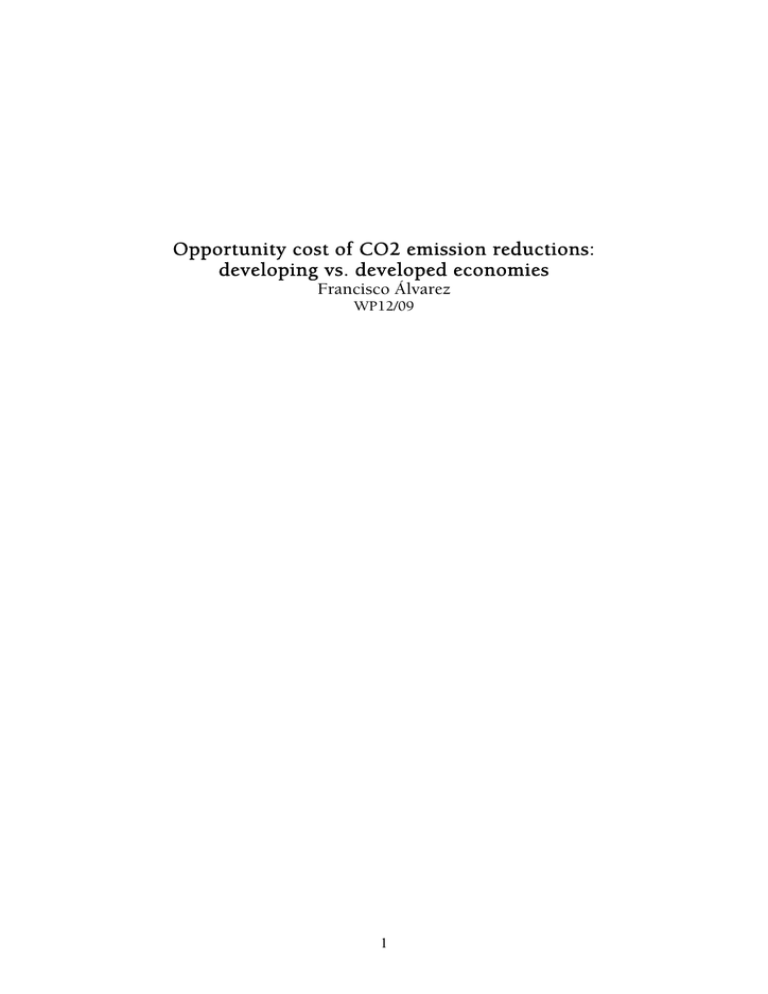
Opportunity cost of CO2 emission reductions:
developing vs. developed economies
Francisco Álvarez
WP12/09
1
2
Resumen
Presentamos evidencia empírica sobre convergencia en magnitudes medioambientales para países
desarrollados y en vías de desarrollo. Además, partiendo de un modelo standard "putty-clay" de
uso de energía, introducimos un stock de contaminación sobre el que se fija un objetivo de reducción de emisiones. El análisis teórico ofrece indicaciones sobre qué variables deberían ser objeto de
futuros acuerdos de reducción de emisiones entre países heterogéneos.
Palabras clave: economía medioambiental, convergencia, reducción de emisiones.
El estudio en que se basa el presente Working Paper ha recibido la financiación de la Dirección General de Planificación y Evaluación de Políticas de Desarrollo (DGPOLDE) del
Ministerio de Asuntos Exteriores y Cooperación (MAEC).
Abstract
We present some empirical evidence on convergence of environmental magnitudes for a pool of
developing and developed countries. Additional, we enlarge a standard model of energy use with
putty-clay technology in order to allow for a stock of pollution, on which a target on emission reductions is set out in finite horizon. The theoretical analysis offers some insights on what variables
should serve as basis of emission reduction target agreements among heterogeneous parties.
Key words:
environment economy, convergence, emission reductions.
The study in which this Working Paper is based on has received the economic support
from the General Direction of Planning and Evaluation of the Development Policies
(DGPOLDE) of the Spanish Ministry of Foreign Affairs and Cooperation (MAEC).
Francisco Álvarez
Dto. Ftos. Analisis Economico II, Universidad Complutense, Fac. CC. Economicas, 28223, Campus Somosaguas, Madrid, Spain.
Instituto Complutense de Estudios Internacionales, Universidad Complutense de Madrid.
Campus de Somosaguas, Finca Mas Ferre. 28223, Pozuelo de Alarcón, Madrid, Spain.
© Francisco Álvarez
ISBN: 978-84-692-4272-8
Depósito legal:
El ICEI no comparte necesariamente las opiniones expresadas en este trabajo, que son de exclusiva responsabilidad de sus autores.
3
4
Índice
1.
Introduction……………………………………………………………………………………7
2.
Empirical analysis……………………………………………………………………………...7
3.
Theoretical model……………………………...……..………………………………………..8
4.
Analysis of the model………...………………………………………………………………..9
4.1
4.2
The basic forces…………………………………………………….……………….…9
Targets and dynamics..………………………………………………………………10
5.
Conclusions…………………………………………………………………………………..11
6.
Bibliographical references……………………………………………………………………12
5
6
1. Introduction
The normative part of this paper takes a step
beyond the econometrics. The previous part
essentially measures the observed relationship
between pollution emissions and economic
growth, but: how does this relationship change
when the economy is pushed further to accomplish a hypothetical emission reduction
agreement? For that, we need to postulate how
the agents of the economy will react to something that has not been experienced so far. In
short, we need a theoretical model of growth
and pollution. In the normative part of this
work we use such a model together with wellknown axiomatic concepts of bargaining in
order to predict the likelihood of emission
reduction agreements between the pool of
2
countries under consideration .
To promote international coordination on
CO2 emission reductions is nowadays -in one
way or another- at the forefront of the environmental policy of virtually any country in
the world. This coordination has been so far
materialised as the signing of agreements by
sovereign countries to commit themselves to
reduce their respective CO2 emissions. From
the raw perspective of a theoretic economist,
this is a tragedy of the commons problem:
there is no supranational entity that can enforce countries to sign, the costs of reductions
are individually paid -at a country level- and
its benefits are worldwide collected. This being
so, it seems natural that road map to the signing of the agreement be not a pleasant walk.
This paper addresses one of the most controversial issues of that road map. Because the
concerned countries’ economies are heterogeneous, we all agree that the emission reductions should be heterogeneous across countries as well. But the devil is in the details:
what do we exactly mean by heterogeneous
economies? and how that heterogeneity
should be mapped into heterogeneity in the
emission reductions?
The rest of the paper is organised as follows.
Next section presents the numerical analysis.
Sections 3 and 4 contain the model and the
theoretical analysis, respectively. Section 5
concludes.
2. Empirical analysis
We have a balanced sample of 14 countries:
the G7 group together with seven Latin American emerging economies. The former are Canada, France, Germany, Italy, Japan, United
Kingdom and the United States of America,
whereas the latter are Argentina, Brazil, Chile,
Colombia, Mexico, Peru and Venezuela. For
each country, we take per capita data on C02
emissions, energy consumption and GDP. All
time series have yearly frequency, and the
3
sample period is 1980 to 2006, both included .
The previous two questions summarize the
two main objectives of this paper, and their
order mimics the order in which they are analyzed. The first is rather positive whereas the
second has clearly a normative angle. Our approach in the positive part is to take data for a
pool of countries which are a priori -yet in a
vague sense- heterogeneous and apply wellknown econometric techniques at use, estimation of convergence equations, to relate economic growth and pollution emissions. Perhaps the more paradigmatic example of heterogeneous economies is that of developed
versus emerging economies. Additionally, we
must bear in mind, if we are to stress heterogeneity between developed and developing
economies, that developed economies should
not be themselves too heterogeneous, and the
like applies for their developing partners. All
in all, our pool is composed of the G7-group
and seven emerging Latin American econo1
mies .
In this part we essentially focus on the study of
convergence across countries. The literature
on convergence typically distinguishes two
sorts of convergence, called beta and sigma
convergence, respectively. Essentially, and
Colombia, Mexico, Peru and Venezuela. Both groups have been
alphabetically listed.
2
There is a branch of literature that explicits -and measures- how
home markets within a country are connected themselves and
uses that information to predict impacts of environmental
policies. These are the so-called computable general equilibrium
models. For the sake of tractability and since we want to focus
on inter rather intra-country allocations, the spirit of this paper
is to view each country as an atom: we look at its aggregate
behavior regardless its internal economic structure.
3
The data source are EIA for energy and emissions and IMF for
GDP.
1
The G7-group is conformed by Canada, France, Germany, Italy,
Japan, United Kingdom and the United States of America. The
Latin American countries we take are Argentina, Brazil, Chile,
7
referred, for instance to per-capita emissions,
by beta convergence we mean that countries
with larger initial levels of emissions (at the
start of the sample period) have experienced
larger reductions in emissions thereafter. By
sigma convergence we mean that the intraperiod cross-country variance of emissions
reduces over time. Roughly, beta convergence
is convergence of the conditional expectation
whereas sigma convergence is convergence of
the unconditional variance of the time series
under consideration.
The table 2 takes a closer look on beta convergence. It shows time-series regressions for
each country in which the yearly growth rate
is regressed against previous year’s level. As
before, a negative coefficient associated to the
previous year’s level shows conditional beta
convergence (the notation was firstly introduced by Sala-i-Marti(1996)). The first and
third column for each magnitude show the
corresponding coefficient without incorporating and incorporating per capita GDP as an
additional regressor, that is, discounting GDP
effects. The second and fourth columns are
standard deviations of the corresponding coefficients. The table shows a pattern of convergence which is relatively stable across countries and across magnitudes, particularly if
GDP is discounted.
The econometric study of convergence is presented in the tables at the end of the paper. We
basically consider four variables: the combinations from CO2 and energy use (labelled as
CO2 and ENE in the table, resp.) with per
capita and intensity units (prefix PC and IN,
resp.). The intensity of CO2 emissions are
emissions per unit of GDP, and intensity of
energy use has an analogous definition. In
some tables we present also measures of convergence of per capita GDP in yellow columns
as a benchmark.
Finally, table 3 shows results on sigma convergence. We present two measures. The first is
standard on the literature on GDP convergence: the evolution of coefficient of variation
along time. This is labelled as ”sigma-con” in
the table for each magnitude. It shows a slow
reduction over time, which indicates sigma
convergence, in sharp contrast with the evolution of ”sigma-con GDP”, in the yellow part,
which is the same statistic referred to the GDP.
We start with beta convergence. The Table 1
shows the result of cross-section regressions of
the overall growth rate over the sample period
against the initial level. A negative coefficient
of the initial level indicates beta-convergence,
also called absolute beta-convergence (see
Sala-i-Marti(1996)). The first and the second
column for each magnitude (PC-CO2, PCENE, IN-CO2 and IN-INE) show that coefficient without taking and taking into account
GDP effects, respectively. The results on overall convergence are weak -to say the best- for
variable measured in per capita units while
they are more robust for the same variables
measured in intensity units.
Additionally, table 3 presents a second measure on convergence: a standard inequality index, which is presented in the columns labelled as ”ine-ind”. For a given year, it is computed as the supreme norm of the cumulative
normalized frequency of observed values and
the corresponding one to a perfectly uniform
distribution. Thus, the index lies in [0, 1] and
the closer to zero, the closer both frequencies
are or, equivalently, the lesser is the heterogeneity across countries. The results for this alternative measure are in line with those for the
coefficient of variation.
Table1: overall convergente
estim.
std
PC_CO2
beta
-0,09
0,07
estim.
std
PC_ENE
beta
-0,09
0,06
disc_GDP
-0,13
0,07
disc_GDP
-0,10
0,06
8
estim.
std
IN_CO2
beta
disc_GDP
-0,39
-0,20
0,14
0,14
estim.
std
IN_INE
beta
disc_GDP
-0,37
-0,14
0,15
0,15
Table 2: beta convergence
CA
FR
GE
IT
JA
UK
US
AR
BR
CH
CO
ME
PE
VE
CA
FR
GE
IT
JA
UK
US
AR
BR
CH
CO
ME
PE
VE
CA
FR
GE
IT
JA
UK
US
AR
BR
CH
CO
ME
PE
VE
PC_CO2
beta_conv
-0,21
-0,34
-0,04
-0,03
-0,03
-0,20
-0,43
-0,23
-0,01
0,00
-0,43
-0,43
-0,16
-0,42
PC_ENE
beta_conv
-0,12
-0,01
-0,15
0,00
-0,02
-0,18
-0,22
-0,02
0,01
0,03
-0,39
-0,12
-0,17
-0,22
IN_CO2
beta_conv
-0,13
-0,18
0,03
-0,14
-0,23
-0,04
-0,07
-0,34
-0,07
-0,50
-0,10
-0,08
-0,15
-0,39
std
0,13
0,06
0,06
0,06
0,07
0,10
0,15
0,18
0,05
0,05
0,17
0,20
0,10
0,15
beta_conv_disc
-0,57
-0,31
-0,36
-0,51
-0,53
-0,40
-0,57
-0,72
-0,40
-0,48
-0,45
-0,61
-0,14
-0,38
std
0,14
0,07
0,16
0,18
0,14
0,17
0,16
0,19
0,12
0,15
0,18
0,20
0,11
0,17
beta_GDP
0,04
0,02
0,02
0,00
0,01
0,04
0,03
0,06
0,04
0,05
0,04
0,05
0,09
0,01
std_GDP
0,01
0,01
0,01
0,01
0,02
0,01
0,01
0,05
0,02
0,02
0,02
0,03
0,05
0,09
std
0,11
0,05
0,07
0,04
0,04
0,11
0,13
0,10
0,03
0,03
0,15
0,15
0,10
0,14
beta_conv_disc
-0,56
-0,39
-0,17
-0,61
-0,32
-0,32
-0,40
-0,81
-0,27
-0,61
-0,47
-0,86
-0,16
-0,61
std
0,18
0,14
0,13
0,16
0,13
0,17
0,16
0,15
0,10
0,13
0,16
0,21
0,10
0,14
beta_GDP
0,04
0,02
0,02
0,00
0,01
0,04
0,03
0,06
0,04
0,05
0,04
0,05
0,09
0,01
std_GDP
0,01
0,01
0,01
0,01
0,02
0,01
0,01
0,05
0,02
0,02
0,02
0,03
0,05
0,09
std
0,05
0,03
0,04
0,08
0,06
0,03
0,02
0,14
0,06
0,17
0,10
0,10
0,14
0,17
beta_conv_disc
-0,48
-0,26
-0,19
-0,58
-0,26
-0,17
-0,34
-0,42
-0,09
-0,51
-0,56
-0,81
-0,79
-0,37
std
0,11
0,06
0,09
0,17
0,09
0,12
0,06
0,14
0,12
0,17
0,20
0,18
0,18
0,16
beta_GDP
0,04
0,02
0,02
0,00
0,01
0,04
0,03
0,06
0,04
0,05
0,04
0,05
0,09
0,01
std_GDP
0,01
0,01
0,01
0,01
0,02
0,01
0,01
0,05
0,02
0,02
0,02
0,03
0,05
0,09
9
Table 2: beta convergente
CA
FR
GE
IT
JA
UK
US
AR
BR
CH
CO
ME
PE
VE
IN_ENE
beta_conv
-0,02
-0,20
-0,01
-0,17
-0,34
-0,02
-0,06
-0,27
-0,07
-0,50
-0,13
-0,13
-0,27
-0,24
std
0,05
0,09
0,03
0,06
0,09
0,03
0,02
0,10
0,04
0,16
0,13
0,10
0,18
0,10
beta_conv_disc
-0,38
-0,50
-0,43
-0,34
-0,36
-0,57
-0,37
-0,24
-0,03
-0,50
-0,72
-0,31
-0,93
-0,18
std
0,15
0,15
0,15
0,12
0,11
0,16
0,08
0,11
0,09
0,16
0,19
0,11
0,18
0,14
beta_GDP
0,04
0,02
0,02
0,00
0,01
0,04
0,03
0,06
0,04
0,05
0,04
0,05
0,09
0,01
std_GDP
0,01
0,01
0,01
0,01
0,02
0,01
0,01
0,05
0,02
0,02
0,02
0,03
0,05
0,09
Table 3: sigma convergence and inequality
PC_CO2
1980
1981
1982
1983
1984
1985
1986
1987
1988
1989
1990
1991
1992
1993
1994
1995
1996
1997
1998
1999
2000
2001
2002
2003
2004
2005
2006
IN_CO2
sigma_con
ine_ind
sigma_conGDP
ine_indGDP
0,83
0,82
0,80
0,81
0,83
0,83
0,83
0,84
0,85
0,84
0,83
0,81
0,82
0,82
0,82
0,81
0,80
0,80
0,79
0,80
0,80
0,79
0,81
0,81
0,80
0,79
0,78
0,32
0,32
0,31
0,32
0,32
0,32
0,32
0,32
0,33
0,32
0,32
0,32
0,32
0,32
0,31
0,31
0,30
0,30
0,29
0,30
0,30
0,30
0,31
0,31
0,31
0,30
0,30
0,49
0,50
0,51
0,53
0,54
0,56
0,55
0,55
0,57
0,59
0,60
0,58
0,58
0,57
0,57
0,57
0,57
0,56
0,57
0,59
0,59
0,60
0,61
0,61
0,60
0,59
0,58
0,22
0,22
0,23
0,24
0,25
0,26
0,25
0,26
0,26
0,28
0,28
0,27
0,27
0,26
0,26
0,27
0,27
0,26
0,26
0,27
0,28
0,28
0,28
0,28
0,28
0,27
0,27
1980
1981
1982
1983
1984
1985
1986
1987
1988
1989
1990
1991
1992
1993
1994
1995
1996
1997
1998
1999
2000
2001
2002
2003
2004
2005
2006
10
sigma_con
ine_ind
sigma_conGDP
ine_indGDP
0,42
0,41
0,39
0,37
0,37
0,37
0,37
0,38
0,37
0,37
0,36
0,35
0,36
0,35
0,36
0,36
0,36
0,36
0,35
0,34
0,34
0,36
0,39
0,38
0,36
0,35
0,33
0,15
0,16
0,15
0,15
0,14
0,15
0,15
0,15
0,15
0,14
0,14
0,14
0,14
0,14
0,14
0,14
0,14
0,13
0,13
0,13
0,13
0,13
0,14
0,14
0,13
0,13
0,12
0,49
0,50
0,51
0,53
0,54
0,56
0,55
0,55
0,57
0,59
0,60
0,58
0,58
0,57
0,57
0,57
0,57
0,56
0,57
0,59
0,59
0,60
0,61
0,61
0,60
0,59
0,58
0,22
0,22
0,23
0,24
0,25
0,26
0,25
0,26
0,26
0,28
0,28
0,27
0,27
0,26
0,26
0,27
0,27
0,26
0,26
0,27
0,28
0,28
0,28
0,28
0,28
0,27
0,27
PC_ENE
1980
1981
1982
1983
1984
1985
1986
1987
1988
1989
1990
1991
1992
1993
1994
1995
1996
1997
1998
1999
2000
2001
2002
2003
2004
2005
2006
IN_ENE
sigma_con
ine_ind
sigma_conGDP
ine_indGDP
0,89
0,87
0,86
0,86
0,87
0,88
0,87
0,87
0,89
0,88
0,86
0,84
0,85
0,84
0,84
0,84
0,83
0,82
0,80
0,82
0,81
0,79
0,81
0,81
0,81
0,80
0,78
0,32
0,32
0,31
0,32
0,32
0,32
0,32
0,32
0,32
0,32
0,32
0,32
0,31
0,31
0,31
0,31
0,31
0,30
0,29
0,30
0,30
0,29
0,30
0,30
0,30
0,29
0,28
0,49
0,50
0,51
0,53
0,54
0,56
0,55
0,55
0,57
0,59
0,60
0,58
0,58
0,57
0,57
0,57
0,57
0,56
0,57
0,59
0,59
0,60
0,61
0,61
0,60
0,59
0,58
0,22
0,22
0,23
0,24
0,25
0,26
0,25
0,26
0,26
0,28
0,28
0,27
0,27
0,26
0,26
0,27
0,27
0,26
0,26
0,27
0,28
0,28
0,28
0,28
0,28
0,27
0,27
1980
1981
1982
1983
1984
1985
1986
1987
1988
1989
1990
1991
1992
1993
1994
1995
1996
1997
1998
1999
2000
2001
2002
2003
2004
2005
2006
sigma_con
ine_ind
sigma_conGDP
ine_indGDP
0,46
0,44
0,43
0,42
0,41
0,40
0,41
0,41
0,40
0,40
0,38
0,39
0,40
0,40
0,41
0,40
0,40
0,40
0,39
0,38
0,37
0,38
0,40
0,40
0,38
0,38
0,36
0,15
0,15
0,15
0,15
0,15
0,14
0,15
0,15
0,14
0,15
0,14
0,14
0,14
0,14
0,15
0,15
0,15
0,14
0,14
0,14
0,13
0,14
0,14
0,14
0,14
0,13
0,13
0,49
0,50
0,51
0,53
0,54
0,56
0,55
0,55
0,57
0,59
0,60
0,58
0,58
0,57
0,57
0,57
0,57
0,56
0,57
0,59
0,59
0,60
0,61
0,61
0,60
0,59
0,58
0,22
0,22
0,23
0,24
0,25
0,26
0,25
0,26
0,26
0,28
0,28
0,27
0,27
0,26
0,26
0,27
0,27
0,26
0,26
0,27
0,28
0,28
0,28
0,28
0,28
0,27
0,27
4
energy prices . Their theoretical explanation to
that fact is as follows. In the economy there is
a state of knowledge represented by a list of
possible capital types. Each type must be used
together with energy in a fixed proportion, and
that proportion varies across types. Now, at
any given moment in time it is given the histogram of capital types, that is, it is given how
many units of each capital type are there, and
all the economic agents can do in the short run
is to use energy accordingly. In the long run,
by making type-specific investments, the
agents can modify the shape of the histogram.
Taking up this central idea, we basically departure from Atkenson and Kehoe in two directions. First, we include a mapping from energy
use to pollution emissions. Second, they
mostly perform an analysis of the steady state
of the economy, whereas we need to make
some different -and standard- assumptions on
3. Theoretical model
In this section we present a theoretical model
in order to predict the countries’ behavior
when facing emission reduction targets. The
model must satisfy two essential characteristics. First, we look for a model able to reproduce -at least qualitatively some observed facts
related to pollution. Second, because an emission reduction target is essentially an emission
ceiling and a deadline at which it must be hit,
a finite-time horizon should be handable
within our setting.
We basically build on Atkenson and Kehoe
(1999). Greenhouse gas emissions are inevitably connected to energy use or, more exactly,
to the use of those energy types that have
served as a basis for economic growth worldwide along the recent decades. The model
proposed by Atkenson and Kehoe delivers a
basic feature observed in the use of those types
of energy: it reacts very slowly to changes in
4
Because in our model we want to focus on the effect of pollution emission targets on the countries behavior, we do not
include energy prices in our model. Precisely the relatively low
short run elasticity to energy prices justifies to neglect the effect
of those prices in a finite horizon analysis.
11
taneous utility function and by r to the time
discount parameter. Finally, an emission reduction target is essentially a pair (T, ¯p),
which indicates that the stock of pollution at
time T cannot exceed ¯p. Let us suppose that
such a target is signed at time 0, being T > 0.
Then the problem for the agent is
the functional forms in order to allow for a
5
finite horizon analysis
We consider continuous time, indexed by t
(with t ≥ 0). Time subscript is omitted where
it is unambiguous. There are two types of capital in the economy, denoted by kp and ka, respectively. If each type of capital is characterized by the proportion in which it uses energy,
and energy use generates pollution, we claim
that each capital type is equivalently defined
by the amount pollution it generates per unit
of capital. Let p be the stock of pollution in the
economy, we assume its dynamics is given by
(4)
subject to pT ≤ ¯p, the feasibility constraint (2)
and the dynamics (3) and (1). The second
term in (4) is a post-target salvage value.
Roughly, the agent anticipates that life will go
on after the agreement deadline and consequently he values to get to that time with some
positive amounts of capital. The value for jtype capital is bj .
(1)
where τ ≥ 0 is the natural abatement rate and h
and g are strictly increasing and differentiable
functions with h (0) = g (0) = 0. In words, kp
generates pollution whereas ka generates
abatement. In addition, we assume kp generates output according to some standard production function f whereas ka does not. Output
can be allocated either to consumption or to
type-specific investment. Denoting consumption by c and j-type investment by xj (being j
™ {p, a}), the feasibility constraint of the economy is
4. Analysis of the model
4.1. THE BASIC FORCES
In order to apply the model to the data, we
need to assume concrete functional forms.
That will be done in the next subsection. Before such specific assumptions come into
scene, we find convenient to perform some
analysis in order to stress the essential effects
we have included in our theoretical setting.
This is the purpose of this subsection.
(2)
In turn, the dynamics of the j-type of capital is
Once an emission reduction target is fixed, our
model is a deterministic finite horizon optimal
control problem. Although kept to a minimum, the use of some terminology of optimal
control eases the presentation. The next
proposition shows that our model delivers a
standard consumption vs. investment trade-off
together with also an standard equal revenue
to investment across capital types rule.
(3)
where δ is the depreciation rate, assumed con6
stant across capital types
Our model economy is ruled by a representative agent that obtains utility exclusively from
consumption and does not obtain disutility
7
from pollution . Let us denote by u its instan-
Proposition 1. Let n denote the current-value
co-state associated to pollution.
5
In fact we are not even studing the transitional dynamics
towards a steady state. We discuss more on this issue latter on.
6
Our two-type economy is an extremely simplified case of
Atkenson and Kehoe’s model, who consider an arbitrary set of
capital types. While adding complexity to the analysis, we claim
that a further generalization in this direction does not bring new
insights to our central question.
7
7As mentioned, greenhouse gas emissions are a tragedy-of-thecommons-problem: the cost of reducing emissions are individually paid whereas benefits from reductions are worldwide
collected. Here we adopt the point of view of a single country: it
must make an effort to reduce its emissions, whose stock is
given by p, but only the aggregate stock across all countries
Under the optimal policy of (4) subject to (1),
(2) and (3), it is
enters its utility. If the country is small enough, such aggregate
stock can be taken as a constant and thus omitted from the
objective function.
12
term in the right hand side, but also its marginal effect on pollution, embodied in the latter term of its right hand side. And that is also
(6), where the first term of the right hand side
is the marginal productivity of ka. Finally, direct comparison of (5) and (6) leads to (7),
which states that the marginal productivity of
kp and ka, left and right hand side, respectively,
must equal each other at every t.
(5)
In addition, it is nt < 0 and n˙t < 0 for all t and
also
4.2. TARGETS AND DYNAMICS
In this subsection we assume the following
functional forms: U(c) = ln(c), f(kp) = kp α,
h(kp) = θh kp and g(ka) = θg ka. Under these
functional forms, the dynamics can be solved
for c such that, from Proposition 1, we have:
(6)
The proof is left to the appendix. Assume to
start that there is no emission target and, consequently, there is no investment in ka. Then
(5) with n = 0 drives the basic dynamics of the
economy, reflecting the usual rule in the dynamics of the consumption as a function of the
stock of productive capital, kp.
(7)
Consequently, the consumption reduces
monotonically over time in the economy.
Equation (8) shows the rate of reduction in
consumption depends on parameters of the
model (eventually different across countries),
whereas its final level depends on the targets
on emissions. More interestingly, for a given
target, the final level on consumption depends
crucially on kp / ka, that is, the ratio of productive to abatement capital. In order to solve the
dynamics of the model, notice that once a solution in c to (8) is given, we obtain straightforwardly the evolution for kp from (7). From
it, the evolution for ka is given by
Now we introduce a target on emission reduction and, therefore, some investment in ka is
8
necessary . There is an immediate consequence. At any point in time, an additional
increase in the stock of pollution obliges to
additional investment in ka and, inevitably, to
additional reductions in consumption. In
short, an additional increase of pollution at
any point in time worsens the functional objective, and that is what the negative sign of nt
accounts for. In addition, its time derivative is
negative simply because the latter the additional increase in pollution takes place, the
lesser time is left to make it compatible with
reaching the target. The latter term in (5) is
negative, indicating that if kp were exogenously fixed at its no-target level at every t,
then increases in consumption would be
smaller (or reductions would be larger) than
its no target counterpart simply because some
consumption should be re-allocated to further
investment in ka.
(8)
which is nothing but the evolution of the aggregate stock of capital in the economy. Now,
given an evolution for both types of capital,
the evolution for p is given by (1), for which
the target constitutes a boundary condition.
The equation (6) is just a rule for the dynamics of consumption in terms of ka as well. In
essence, the standard rule in a capital accumulation model without pollution compares the
time derivative of consumption with the marginal productivity of capital net from depreciation and time discount. This is (5), where the
marginal productivity of kp is not only the first
The dynamics can be synthesized in a phasediagram in the kp ka plane. From a given initial
point in it, that is, a pair of values (kp, ka),
there is a unique trajectory that goes to a north
eastern final point (thus increasing both types
of capital), following the previous dynamics,
in which the target is exactly met. We can also
define a map of indifference curves with regard
to the initial point. Roughly, any two distinct
initial points placed in the same indifference
curve lead the economy to different final north
8
We assume implicitly that the emission target is not reached
under a business-as-usual policy, that is, the target is not superfluous.
13
eastern points, but the representative consumer is indifferent among the consumption
paths induced from those trajectories. Numerical analysis reveals that the indifferent
curves are strictly increasing functions.
composed by a single individual, that is just
the numerator), but its initial intensity of
emissions. So long as that ratio converges over
time, as the analysis of the previous section
suggests, there seem to be increasing reasons
to have apparently different countries facing
common-value targets.
To understand the practical relevance of the
previous analysis, notice that a pair (kp, ka)
determines a unique value of the ratio
5. Conclusions
We use standard econometric techniques on
the study of convergence of environmental
magnitudes for a pool of developing and developed countries. We also present a first attempt to build on a model of energy use to
study finite-horizon targets on emission reduction agreements. Preliminary as it is, our
analysis so far suggests that such agreements
among targets should be contingent on a larger
set of economic variables than what usually
are.
(9)
The numerator are the emissions at a given
instant, whereas the denominator is the total
output of the economy, thus the ratio are the
emissions measured in units of intensity. The
previous analysis thus shows that the relevant
variable to measure how much effort a country
must make in order to met an emission reduction target is not given by its initial per capita
emissions (assuming that our economy is
14
Bibliographical References
[1] Atkeson, A. and P. J. Kehoe: Models of Energy Use: Putty-Putty versus Putty- Clay. The American Economic Review, Vol. 89, No. 4 (Sep., 1999), pp. 1028-1043
[2] Grossman G. M. and Alan B. Krueger: Economic Growth and the Environment. The Quarterly Journal of
Economics, Vol. 110, No. 2 (May, 1995), pp. 353-377
[3] Sala-i-Martin, X. X: Regional Cohesion: Evidence and Theories of Regional Growth and Convergence.
European Economic Review 40 (1996), pp. 1325-1352.
15
Últimos títulos publicados
DOCUMENTOS DE TRABAJO “EL VALOR ECONÓMICO DEL ESPAÑOL”
DT 13/08
de Diego Álvarez, Dorotea; Rodrigues-Silveira, Rodrigo; Carrera Troyano Miguel: Estrate-
gias para el Desarrollo del Cluster de Enseñanza de Español en Salamanca
DT 12/08
Quirós Romero, Cipriano: Lengua e internacionalización: El papel de la lengua en la inter-
nacionalización de las operadoras de telecomunicaciones.
DT 11/08
Girón, Francisco Javier; Cañada, Agustín: La contribución de la lengua española al PIB y al
empleo: una aproximación macroeconómica.
DT 10/08
Jiménez, Juan Carlos; Narbona, Aranzazu: El español en el comercio internacional.
DT 09/07
Carrera, Miguel; Ogonowski, Michał: El valor económico del español: España ante el espejo
de Polonia.
DT 08/07
Rojo, Guillermo: El español en la red.
DT 07/07
Carrera, Miguel; Bonete, Rafael; Muñoz de Bustillo, Rafael: El programa ERASMUS en el
marco del valor económico de la Enseñanza del Español como Lengua Extranjera.
DT 06/07
Criado, María Jesús: Inmigración y población latina en los Estados Unidos: un perfil socio-
demográfico.
DT 05/07
Gutiérrez, Rodolfo: Lengua, migraciones y mercado de trabajo.
DT 04/07
Quirós Romero, Cipriano; Crespo Galán, Jorge: Sociedad de la Información y presencia del
español en Internet.
DT 03/06
Moreno Fernández, Francisco; Otero Roth, Jaime: Demografía de la lengua española.
DT 02/06
Alonso, José Antonio: Naturaleza económica de la lengua.
DT 01/06
Jiménez, Juan Carlos: La Economía de la lengua: una visión de conjunto.
WORKING PAPERS
WP 12/09
Álvarez, Francisco: Oportunity cost of CO2 emission reductions: developing vs. developed
economies.
WP 11/09
J. André, Francisco: Los Biocombustibles. El Estado de la cuestión.
WP 10/09
Luengo, Fernando: Las deslocalizaciones internacionales. Una visión desde la economía
crítica
WP 09/09
Dobado, Rafael; Guerrero, David: The Integration of Western Hemisphere Grain Markets in
the Eighteenth Century: Early Progress and Decline of Globalization.
WP 08/09
Álvarez, Isabel; Marín, Raquel; Maldonado, Georgina: Internal and external factors of com-
petitiveness in the middle-income countries.
WP 07/09
Minondo, Asier: Especialización productiva y crecimiento en los países de renta media.
WP 06/09
Martín, Víctor; Donoso, Vicente: Selección de mercados prioritarios para los Países de Renta
Media.
16
WP 05/09
Donoso, Vicente; Martín, Víctor: Exportaciones y crecimiento económico: estudios empíri-
cos.
WP 04/09
Minondo, Asier; Requena, Francisco: ¿Qué explica las diferencias en el crecimiento de las
exportaciones entre los países de renta media?
WP 03/09
Alonso, José Antonio; Garcimartín, Carlos: The Determinants of Institutional Quality. More
on the Debate.
WP 02/09
Granda, Inés; Fonfría, Antonio: Technology and economic inequality effects on interna-
tional trade.
WP 01/09
Molero, José; Portela, Javier y Álvarez Isabel: Innovative MNEs’ Subsidiaries in different
domestic environments.
WP 08/08
Boege, Volker; Brown, Anne; Clements, Kevin y Nolan Anna: ¿Qué es lo “fallido”? ¿Los
Estados del Sur,o la investigación y las políticas de Occidente? Un estudio sobre órdenes
políticos híbridos y los Estados emergentes.
WP 07/08
Medialdea García, Bibiana; Álvarez Peralta, Nacho: Liberalización financiera internacional,
inversores institucionales y gobierno corporativo de la empresa
WP 06/08
Álvarez, Isabel; Marín, Raquel: FDI and world heterogeneities: The role of absorptive ca-
pacities
WP 05/08
Molero, José; García, Antonio: Factors affecting innovation revisited
WP 04/08
Tezanos Vázquez, Sergio: The Spanish pattern of aid giving
WP 03/08
Fernández, Esther; Pérez, Rafaela; Ruiz, Jesús: Double Dividend in an Endogenous Growth
Model with Pollution and Abatement
WP 02/08
Álvarez, Francisco; Camiña, Ester: Moral hazard and tradeable pollution emission permits.
WP 01/08
Cerdá Tena, Emilio; Quiroga Gómez, Sonia: Cost-loss decision models with risk aversion.
WP 05/07
Palazuelos, Enrique; García, Clara: La transición energética en China.
WP 04/07
Palazuelos, Enrique: Dinámica macroeconómica de Estados Unidos: ¿Transición entre dos
recesiones?
WP 03/07
Angulo, Gloria: Opinión pública, participación ciudadana y política de cooperación en España.
WP 02/07
Luengo, Fernando; Álvarez, Ignacio: Integración comercial y dinámica económica: España
ante el reto de la ampliación.
WP 01/07
Álvarez, Isabel; Magaña, Gerardo: ICT and Cross-Country Comparisons: A proposal of a
new composite index.
WP 05/06
Schünemann, Julia: Cooperación interregional e interregionalismo: una aproximación so-
cial-constructivista.
WP 04/06
Kruijt, Dirk: América Latina. Democracia, pobreza y violencia: Viejos y nuevos actores.
WP 03/06
Donoso, Vicente; Martín, Víctor: Exportaciones y crecimiento en España (1980-2004):
Cointegración y simulación de Montecarlo.
WP 02/06
García Sánchez, Antonio; Molero, José: Innovación en servicios en la UE: Una aproximación
a la densidad de innovación y la importancia económica de los innovadores a partir de los
datos agregados de la CIS3.
WP 01/06
Briscoe, Ivan: Debt crises, political change and the state in the developing world.
17
WP 06/05
Palazuelos, Enrique: Fases del crecimiento económico de los países de la Unión Europea–
15.
WP 05/05
Leyra, Begoña: Trabajo infantil femenino: Las niñas en las calles de la Ciudad de México.
WP 04/05
Álvarez, Isabel; Fonfría, Antonio; Marín Raquel: The role of networking in the competitive-
ness profile of Spanish firms.
WP 03/05
Kausch, Kristina; Barreñada, Isaías: Alliance of Civilizations. International Security and
Cosmopolitan Democracy.
WP 02/05
Sastre, Luis: An alternative model for the trade balance of countries with open economies:
the Spanish case.
WP 01/05
Díaz de la Guardia, Carlos; Molero, José; Valadez, Patricia: International competitiveness in
services in some European countries: Basic facts and a preliminary attempt of interpretation.
WP 03/04
Angulo, Gloria: La opinión pública española y la ayuda al desarrollo.
WP 02/04
Freres, Christian; Mold, Andrew: European Union trade policy and the poor. Towards improving the poverty impact of the GSP in Latin America.
WP 01/04
Álvarez, Isabel; Molero, José: Technology and the generation of international knowledge
spillovers. An application to Spanish manufacturing firms.
POLICY PAPERS
PP 02/09
Carrasco Gallego ,José Antonio: La Ronda de Doha y los países de renta media.
PP 01/09
Rodríguez Blanco, Eugenia: Género, Cultura y Desarrollo: Límites y oportunidades para el
cambio cultural pro-igualdad de género en Mozambique.
PP 04/08
Tezanos, Sergio: Políticas públicas de apoyo a la investigación para el desarrollo. Los casos
de Canadá, Holanda y Reino Unido
PP 03/08
Mattioli, Natalia Including Disability into Development Cooperation. Analysis of Initiatives
by National and International Donors
PP 02/08
Elizondo, Luis: Espacio para Respirar: El humanitarismo en Afganistán (2001-2008).
PP 01/08
Caramés Boada, Albert: Desarme como vínculo entre seguridad y desarrollo. La reintegra-
ción comunitaria en los programas de Desarme, desmovilización y reintegración (DDR) de
combatientes en Haití.
PP 03/07
Guimón, José: Government strategies to attract R&D-intensive FDI.
PP 02/07
Czaplińska, Agata: Building public support for development cooperation.
PP 01/07
Martínez, Ignacio: La cooperación de las ONGD españolas en Perú: hacia una acción más
estratégica.
PP 02/06
Ruiz Sandoval, Erika: Latinoamericanos con destino a Europa: Migración, remesas y codesa-
rrollo como temas emergentes en la relación UE-AL.
PP 01/06
Freres, Christian; Sanahuja, José Antonio: Hacia una nueva estrategia en las relaciones
Unión Europea – América Latina.
PP 04/05
Manalo, Rosario; Reyes, Melanie: The MDGs: Boon or bane for gender equality and wo-
men’s rights?
PP 03/05
Fernández, Rafael: Irlanda y Finlandia: dos modelos de especialización en tecnologías avan-
zadas.
PP 02/05
Alonso, José Antonio; Garcimartín, Carlos: Apertura comercial y estrategia de desarrollo.
18
PP 01/05
Lorente, Maite: Diálogos entre culturas: una reflexión sobre feminismo, género, desarrollo y
mujeres indígenas kichwuas.
PP 02/04
Álvarez, Isabel: La política europea de I+D: Situación actual y perspectivas.
PP 01/04
Alonso, José Antonio; Lozano, Liliana; Prialé, María Ángela: La cooperación cultural espa-
ñola: Más allá de la promoción exterior.
19

